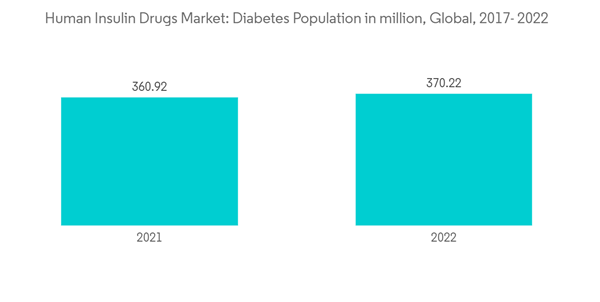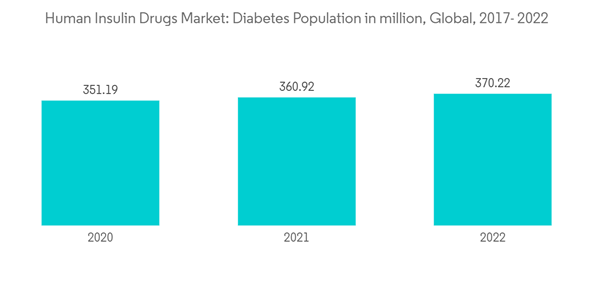The Human Insulin Drugs Market size is estimated at USD 27.96 billion in 2024, and is expected to reach USD 33.81 billion by 2029, growing at a CAGR of 3.87% during the forecast period (2024-2029).
The COVID-19 pandemic has had a substantial impact on the Human Insulin Drugs Market. Type-1 diabetes patients are impacted more during Covid-19. People with diabetes are having a weak immune system so, with COVID-19, the immune system gets weaker very fast. People with diabetes will have more chances to get into serious complications rather than normal people.
Diabetes is associated with many health complications. People with diabetes have a 300% increased risk of being hospitalized compared to those without diabetes, and thus, they incur more healthcare expenses compared to non-diabetic people. Patients with Type 2 diabetes require many corrections throughout the day for maintaining nominal blood glucose levels, such as the administration of additional insulin or ingestion of additional carbohydrates. Furthermore, patients attempting to control their blood glucose levels, so as to prevent the long-term complications associated with fluctuations in blood glucose levels, are at greater risk for overcorrection and the resultant hypoglycemia.
Therefore, owing to the aforementioned factors the studied market is anticipated to witness growth over the analysis period.
There was a glaring research gap in the absence of data for adult populations because only 1.52 million of the 8.75 million people with type-1 diabetes worldwide in 2022 were under the age of 20. If type-1 diabetes is not correctly diagnosed and promptly treated, it can lead to diabetic ketoacidosis, which can quickly result in death. Type-1 diabetes and the use of insulin were reported by 1.4 million individuals aged 20 or older, or 5.2% of all US adults with diagnosed diabetes, while 10.9% of all US adults with diagnosed diabetes, or 2.9 million adults aged 20 or older, started taking insulin within a year after diagnosis. Regular insulin is used along with a healthy diet and exercise routine to help diabetics with high blood sugar levels. Keeping blood sugar levels under control helps prevent kidney damage, blindness, nerve damage, limb loss, and issues with sexual function. Your chance of having a heart attack or stroke may be reduced if your diabetes is well controlled. This synthetic insulin is identical to human insulin. It takes the place of the insulin that your body typically produces. This insulin has a short half-life. It functions by making it easier for blood sugar (glucose) to enter cells where your body can use it as fuel. Usually, this drug is used with either a medium-acting or long-acting insulin product. The use of this medication with other oral diabetic medications is also possible.
Therefore, owing to the aforesaid factors, the growth of the studied market is anticipated.
Therefore, owing to the aforesaid factors, the growth of the studied market is anticipated in the human insulin drug market.
This product will be delivered within 2 business days.
The COVID-19 pandemic has had a substantial impact on the Human Insulin Drugs Market. Type-1 diabetes patients are impacted more during Covid-19. People with diabetes are having a weak immune system so, with COVID-19, the immune system gets weaker very fast. People with diabetes will have more chances to get into serious complications rather than normal people.
Diabetes is associated with many health complications. People with diabetes have a 300% increased risk of being hospitalized compared to those without diabetes, and thus, they incur more healthcare expenses compared to non-diabetic people. Patients with Type 2 diabetes require many corrections throughout the day for maintaining nominal blood glucose levels, such as the administration of additional insulin or ingestion of additional carbohydrates. Furthermore, patients attempting to control their blood glucose levels, so as to prevent the long-term complications associated with fluctuations in blood glucose levels, are at greater risk for overcorrection and the resultant hypoglycemia.
Therefore, owing to the aforementioned factors the studied market is anticipated to witness growth over the analysis period.
Insulin Market Trends
Growing Diabetes Prevalence Driving the Market
All type-1 diabetes patients and a limited number of type-2 diabetes patients require daily insulin injections as part of their treatment. As per the ADA, around 67.3% of the cost of diabetes care in the United States is covered by government insurance (including Medicare, Medicaid, and the military). The rest is paid for by private insurance (30.7%) or by the uninsured (2%). In Canada, the total diabetic population in the country increased by approximately 33% between 2016 and 2022, and about 8% of the diabetic population has type-1 diabetes. Many developing countries in North America, including the Caribbean countries, are undergoing an epidemiologic transition and experiencing rapid increases in the prevalence of diabetes. As of 2022, the prevalence rates for diabetes ranged from 12% to 19% of the population in several countries in the region.There was a glaring research gap in the absence of data for adult populations because only 1.52 million of the 8.75 million people with type-1 diabetes worldwide in 2022 were under the age of 20. If type-1 diabetes is not correctly diagnosed and promptly treated, it can lead to diabetic ketoacidosis, which can quickly result in death. Type-1 diabetes and the use of insulin were reported by 1.4 million individuals aged 20 or older, or 5.2% of all US adults with diagnosed diabetes, while 10.9% of all US adults with diagnosed diabetes, or 2.9 million adults aged 20 or older, started taking insulin within a year after diagnosis. Regular insulin is used along with a healthy diet and exercise routine to help diabetics with high blood sugar levels. Keeping blood sugar levels under control helps prevent kidney damage, blindness, nerve damage, limb loss, and issues with sexual function. Your chance of having a heart attack or stroke may be reduced if your diabetes is well controlled. This synthetic insulin is identical to human insulin. It takes the place of the insulin that your body typically produces. This insulin has a short half-life. It functions by making it easier for blood sugar (glucose) to enter cells where your body can use it as fuel. Usually, this drug is used with either a medium-acting or long-acting insulin product. The use of this medication with other oral diabetic medications is also possible.
Therefore, owing to the aforesaid factors, the growth of the studied market is anticipated.
North America Dominates the Market
North America dominates the global human insulin market, especially the United States, owing to the high prevalence of diabetes in the region because of a sedentary lifestyle. The cost factor is the major concern in the United States, where almost 50% of the insulin revenues for the manufacturers are from the country itself. The United States accounts for the highest sales of long-acting insulin, Lantus, across the world. Most diabetic drug manufacturing companies consider the country a critical market for improving overall global sales. Lantus is the most commonly administered basal insulin across the world, accounting for a dominant share in the US market. The traditional North American human insulin drug market is expected to grow during the forecast period due to its affordability to patients. Humulin holds the highest market share, followed by Novolin. There are no generic competitors for the traditional North American human insulin drug market in the United States. The United States accounts for the highest sales of Humalog across the world, with over 56% of the market share. The majority of diabetes drug manufacturing companies consider the country a critical market for improving overall global sales. In the United States, Humalog is available in different varieties under names like Humalog Mix 75/25, Humalog U-100, Humalog U-200, and Humalog Mix 50/50 for the treatment of diabetes.Therefore, owing to the aforesaid factors, the growth of the studied market is anticipated in the human insulin drug market.
Insulin Industry Overview
The global human insulin market is highly consolidated, with three major manufacturers holding a global market presence and the remaining manufacturers confined to other local or region-specific manufacturers. Mergers and acquisitions that happened between the players in the recent past have helped the companies strengthen their market presence. Eli Lilly and Boehringer Ingelheim have an alliance to develop and commercialize Basaglar (Insulin Glargine). Biocon is developing Insulin Tregopil, an oral prandial insulin tablet, for the treatment of type-1 and type-2 diabetes mellitus. Fast-acting oral insulin could improve postprandial glucose control with reduced side effects and greater adherence, thus holding the promise to transform T1D management. Oramed Pharmaceuticals Inc., a clinical-stage pharmaceutical company focused on the development of oral drug delivery systems, is working to bring the first oral insulin product to market, thus providing a more convenient, effective, and safer method for delivering insulin therapy.Additional Benefits:
- The market estimate (ME) sheet in Excel format
- 3 months of analyst support
This product will be delivered within 2 business days.
Table of Contents
1 INTRODUCTION
4 MARKET DYNAMICS
5 MARKET SEGMENTATION
6 MARKET INDICATORS
7 COMPETITIVE LANDSCAPE
Companies Mentioned (Partial List)
A selection of companies mentioned in this report includes, but is not limited to:
- Novo Nordisk A/S
- Sanofi S.A.
- Eli Lilly and Company
- Biocon Limited
- Pfizer Inc.
- Wockhardt
- Julphar
- Exir
- Sedico
Methodology

LOADING...










